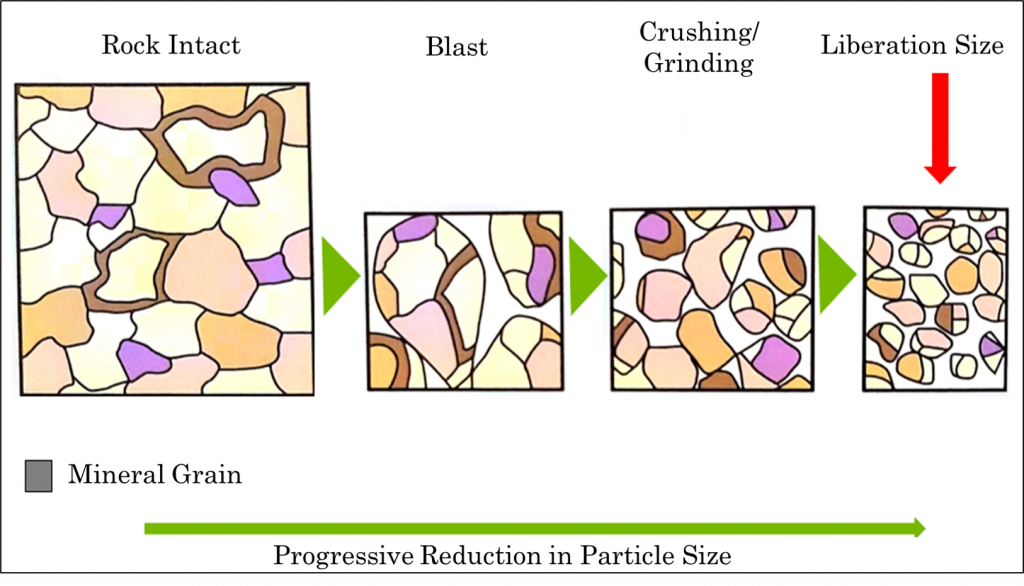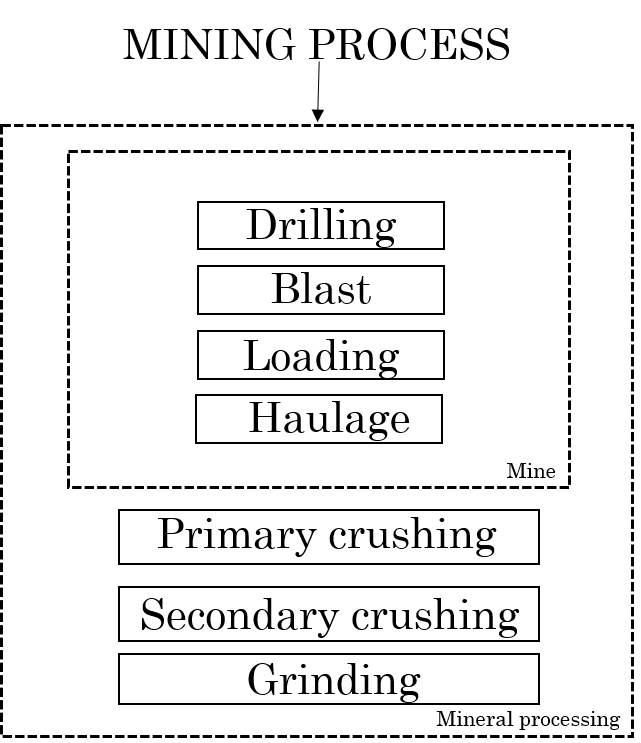Several investigations carried out over the years by various authors such as Eloranta (Eloranta, 1995), Kojovic and Wedmair (Kojovic & Wedmair, 1995), have shown that extractive production activities and processing phases in ore treatment facilities are interdependent, and the results of rock blasting processes and subsequent activities, have direct impacts on the efficiency and production of comminution equipment, which are crushing and grinding.
According to Martins (Martins, 2015), the Mine to Mill approach is based on the identification of constraints and possible opportunities to maximize the profitability of the global process that involves the entire mining enterprise, seeking to understand the interaction and relevance of the adjacent steps in each phase, emphasizing that one should not observe the processes individually but in a global way. Other authors such as Adel, Kojovic and Thornton (Adel, Kojovic, & Thornton, 2006), point out that the Mine to Mill concept is defined as the process of joint optimization of the mining and mineral processing phases. In this context, the search for strategies to minimize energy consumption during the whole process of granulometric reduction of the material in question appears to be paramount.
Authors such as Luz, França and Braga (Luz, França, & Braga, 2018), explain that in most mining operations, the material explored goes through three stages of comminution, namely:
- Blast: preparing the material for the loading and haulage stages;
- Crushing: it is the first step of granulometric reduction in the processing plant, improving the handling characteristics of the ore, preparing it for the milling process;
- Grinding: usually carried out in two stages (primary and secondary grinding), it reduces the material to very fine granulometries (according to the texture and liberation size). It aims to free the useful phase of the ore.

Kanchibotla and Valery (Kanchibotla & Valery, 2010) explain that in the Mine to Mill approach, comminution must be analyzed right at the beginning of the production chain, where energy requirements are lower and less expensive. In general, this approach will allow to equate a better energy distribution during the process of rock blasting, in which it will have to guarantee a control of the size of the coarsest and finest materials. Our partner WipWare can help you to know your real granulometric curve generated by your blasting.

For operations that carried out the process of obtaining a finer and improved fragmentation (for the benefit of the processes in the installation and processing), the mine is rarely willing to return to the old ways of blasting rocks at a reduced cost. The reason is that the operations intrinsic to the mine also benefit a lot from more consistent fragmentation, with less heavy gauge material to process (Dance, 2007). The same author also explains that if drilling and blasting operations need to be increased (cost increased by about 7 to 10% in mine expenses) to improve the quality of fragmentation, the costs exceeded will be outweighed by the reduction in the workshop’s operational expenses mineral processing (obviously, up to a certain limit).

Authors like McKee (McKee, 2013) state that when the stages of mine and mineral processing are combined and implemented effectively as required by the Mine to Mill approach, productivity gains in the range of 10% to 20% can be achieved. Following this same reasoning, the Julius Kruttschnitt Mineral Research Center – JKMRC declares that the productivity of the companies that adhered to this method had already reached profits of around AUD 50,000,000. Adel, Kojovic, and Thornton (Adel, Kojovic, & Thornton, 2006) go so far as to claim that although the Mine to Mill application is more widespread in large metal mines, this technique can also be applied to the aggregate industry as the focus it is reduced only in the particle size reduction by blasting rocks and crushing, making it possible to simulate processes to find the global optimization of these types of projects.
Soon I will bring more content on this subject.
I hope you like it 😉





